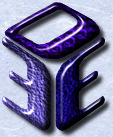| About... | |
| Tools... |
 |
D3E Publisher's Toolkit v4.1.1 |
This version was developed by John Weatherley [jweather@ucar.edu] from v4.1 of the toolkit. It adds a Java Swing interface, a number of new features, and a redesigned user interface as a result of usability evaluations. This is currently being added to v5.0.
Documentation is all online, embedded in the interface. A Masters Thesis [PDF: 900K] on the design rationale behind it is available.

(from the Masters Thesis)
The screenshot shows the primary screen in the prototype GUI. In this design, widgets for performing the editor's tasks are made most prominent. Item 4 in the figure is the Articles panel that controls the inputs necessary to configure and generate an individual document. This panel is visible at all times. Common tasks such as opening a saved articles settings, deleting and creating new settings follow standard convention and are found under the "File"menu (item 1). To aid in technically complex tasks, help buttons are available next to each widget in the panel (item 6). Clicking a help button brings up specific information and examples for input related to the entry. Item 5 shows the authors, editors and reviewers entry boxes. Clicking "Add" brings up a persistent address book that allows the editor to save and retrieve these contacts, reducing the need for repeated data entry over time and providing built-in error checking. Item 3 shows the output preview buttons and the document processing button, "Go." Each of these buttons as well as the "Save" button provides feedback to the user by becoming enabled when they are ready for use. An integrated HTML viewer is accessed via the "Full Article," "Discussion Header" and "View Input File" buttons, eliminating the need to use a secondary tool to preview the document and it's corresponding output. The "Input File" and "Output Folder" are selected using a standard file chooser interface, replacing the simple text entry interface in the previous toolkit.
The prototype toolkit clearly segregates each user role into separate UI areas. Item 4 in the Articles panel, allows input for the editor. The "Publication" menu seen at item 1 provides access to the system administrator's preference panel. The web site designer modifies a set of templates and GUI configuration files that are in the "custom-templates" folder at the same directory level as the toolkit executable. In this way, all tasks that are not related to preparing documents are moved away from the editor, simplifying their task.
| About... | |
| Tools... |